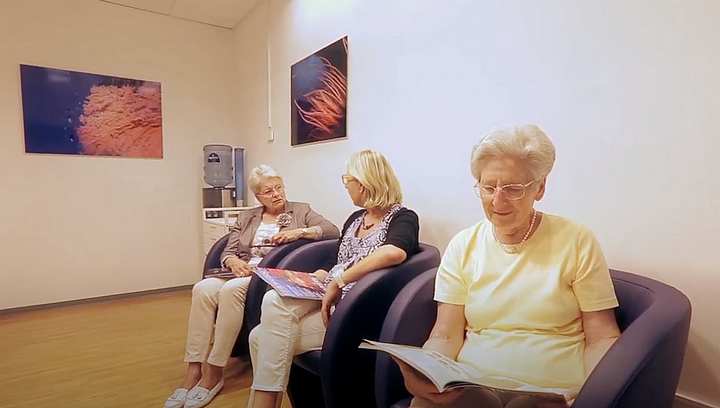 The patients you see may appear to be in a pleasant reception area but are in reality undergoing treatment.
The patients you see may appear to be in a pleasant reception area but are in reality undergoing treatment.
Simulated daylight photodynamic therapy (PDT) is a remarkable advance. Designed to treat actinic keratosis, or milder cases of squamous cell carcinoma as standard PDT does but without the disadvantages.
Treatment is gentle and painless, avoiding discomfort, stress, or cardiovascular disturbance. The effect is uniform, with no specific targeting needed, beyond a patient and their consultant deciding which areas are uncovered.
In most cases, this will be the same areas that are exposed to the sun in daily life. The reason over 10% of us suffer from actinic keratosis at some stage, or rarer Bowen’s disease, which can be treated in the same way.
An Increasing Requirement
We had an artificial daylight PDT room built in our London clinic because of patient needs. The incidence of skin cancer has increased significantly in recent years, with actinic keratosis heading the list.
The condition is troublesome and can turn into squamous cell carcinoma, a more virulent type of skin cancer. Offering curative treatment which is pleasurable makes sense and encourages more people not to avoid care.
Far better if patients can opt for an effective, modern approach to treatment. Where they feel safe, in a treatment zone which seems natural.
Treatment Methodology
You can expect treatment to last between 2 and 4 hours. By all means bring a book, magazines, or particular refreshments if you wish. The time really is that relaxed, although closely monitored by our staff.
They may carry out a little pre-treatment, perhaps gentle removal of any overlying crusty skin and ensuring key areas are clean. A light sensitizer in the form of a cream will be applied, which enhances PDT treatment.
The cream is in reality a nanoemulsion, containing protoporphyrin IX, which targets and accumulates in neoplastic cells. These are cells which grow abnormally, forming potentially cancerous areas.
Then simply a case of spending time in a room with a closely optimised light spectrum, which is available at any time of the year.
Continuous Daylight
Open air daylight photodynamic therapy has been tried and shown some success, along with limitations. Times of year, or day when this is helpful are restrictive and the approach has a built in issue.
You are exposed to full sunlight, which includes the unwanted UV rays that can cause skin cancer. Sound use of sunscreen will help but patients are still spending time in an environment able to damage their skin.
Artificial daylight PDT avoids this, by only creating light in a spectrum ranging from 570 nm to 630 nm, outside the UV range. This avoids any potential damage but is ideal for the required treatment.
Energy levels required for the phototoxic reaction to take place in abnormal cells are always available. The consistency allows the protoporphyrin to work in a continuous, yet controlled way, making treatment virtually painless.
A Proven Approach
Simulated daylight PDT is a breakthrough treatment, yet is well proven, along with the most effective sensitiser. By all means see more on research to date and the welcome results this has provided.
You can also view a video and further details on why the treatment has been developed and how the PDT room is created. This mentions a bonus that daylight PDT can offer, stimulation of collagen, with a rejuvenating effect on your skin.
Daylight PDT does hold potential for wider treatment on sun damaged skin, although the focus is on actinic keratosis. A widespread problem, which now has a readily available, safe and dependable solution.
